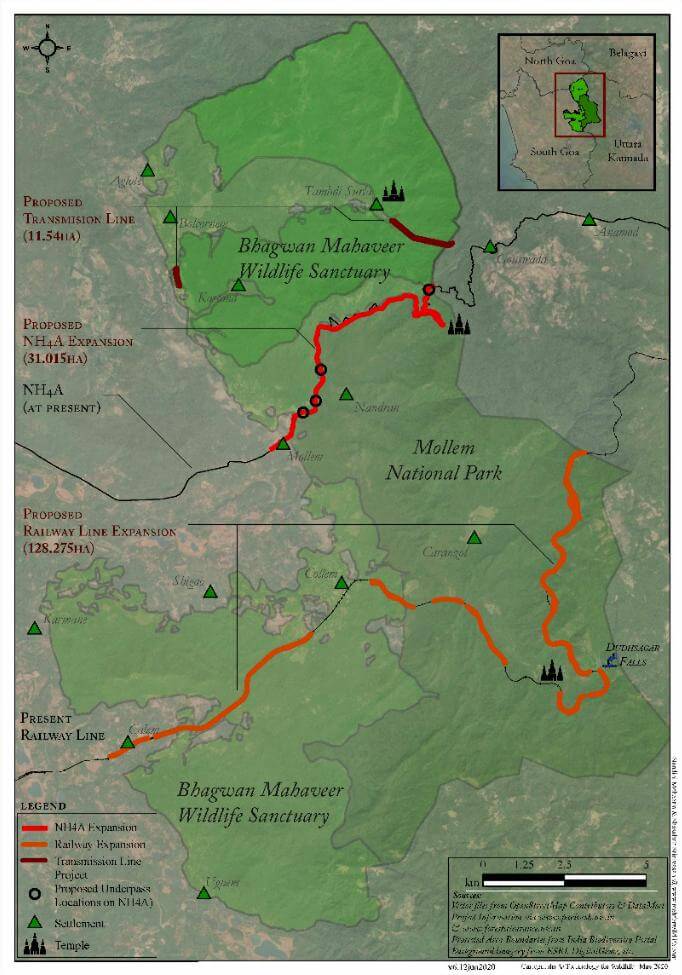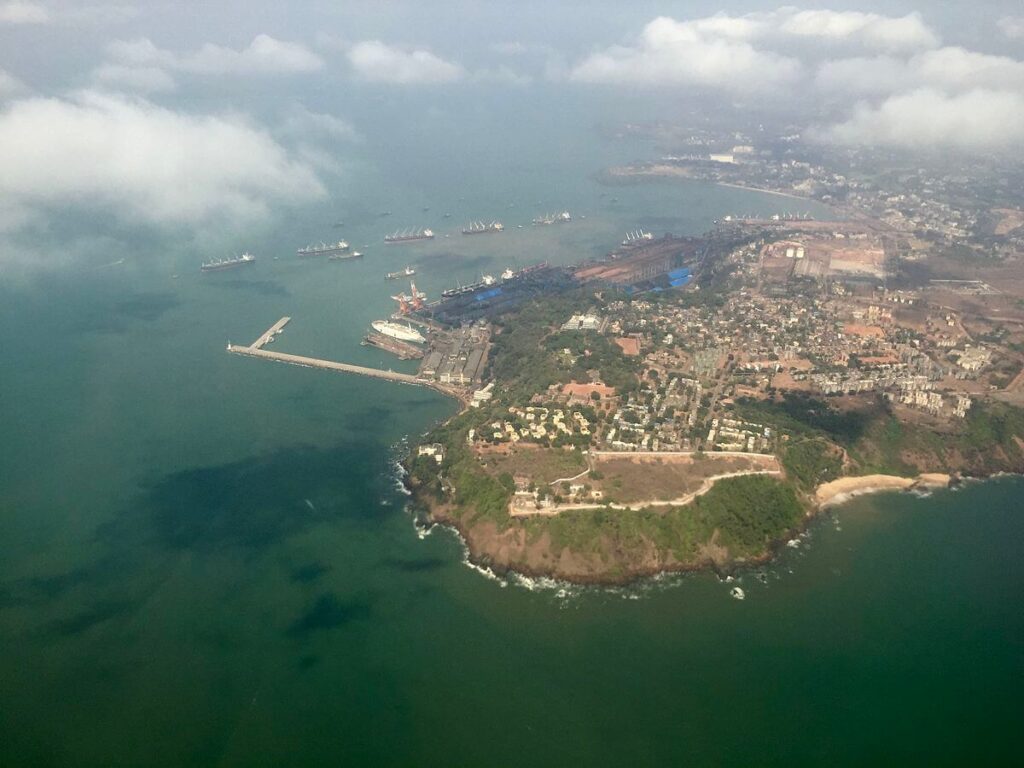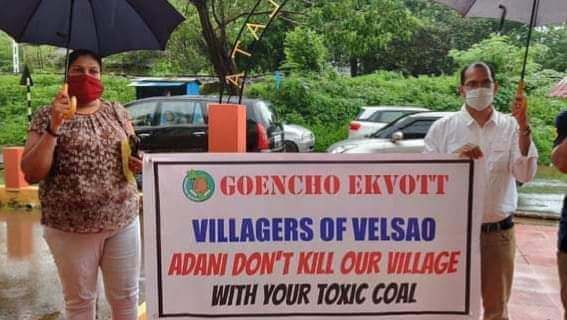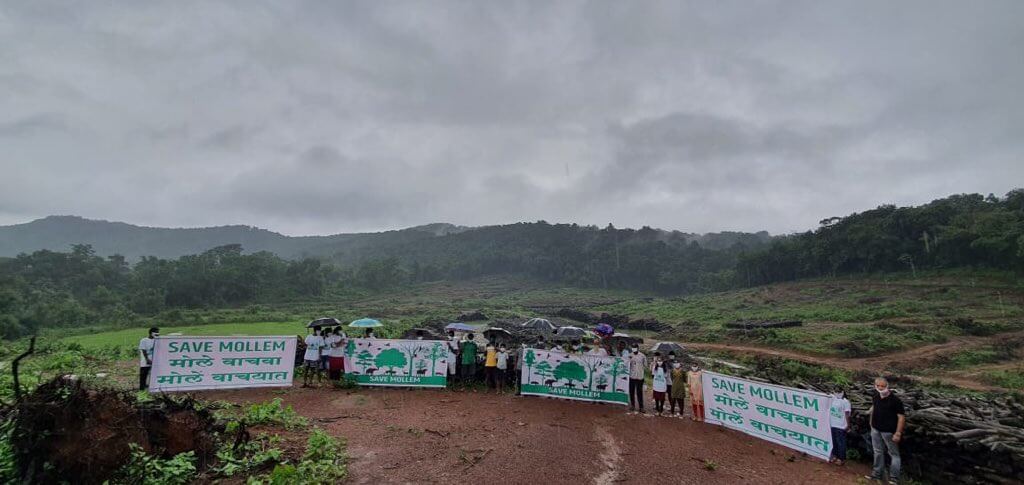In 2011, ecologist Madhav Gadgil chaired the Western Ghats Ecology Expert Panel (WGEEP) which submitted a report wherein all of the Western Ghats was designated to be an Ecologically Sensitive Area. They graded regions in the Ghats into different “Economic Sensitive Zones” (ESZs). For the most sensitive ESZ1 regions, which included National Parks, they strongly suggested “no new railway lines and major roads, except where it is highly essential”.
Yet, nine years later, in July 2020, the National Board for Wildlife virtually cleared the double-tracking of a railway line which cuts through Goa’s pristine Bhagwan Mahaveer Wildlife Sanctuary and Mollem National Park. Such is the ecological importance of the Sanctuary that although it covers just about 0.05% of the entire Western Ghats, it nurtures 8% of the species endemic to the region.
What’s worse is that this railway expansion is just one of the three linear projects set to affect the protected areas. A four-lane highway expansion and a 400-kilovolt transmission line are also set to follow. In all, these three projects would divert 250 hectares of forest land in the Wildlife Sanctuary.
“The authorities are giving a rationale for the projects that seems implausible,” says Gabriella D’Cruz, part of Amche Mollem (konkani for “My Mollem”). Amche Mollem is a citizen-led campaign that is highlighting the ecological importance of Mollem in the face of the proposed projects.“They say the highway expansion will reduce traffic jams in the area. But where is the data that supports this?” asks Gabriella.
Another rationale, albeit not as apparent, is hard to miss. The two linear projects would definitely make transport faster and more convenient; not just for people, but also for moving iron ore and coal.
Preparing the Ground for Transporting Coal
As far as mining iron ore is concerned, in 2014, the Supreme Court found all iron ore leaseholders guilty of mining for five years in Goa without a valid mining lease. It then declared all of them illegal. In 2018, the apex court cancelled 88 mining leases, ordering the state to grant fresh mining leases strictly as per the provisions of the Mines and Minerals (Development and Regulation) Act, 1957.
But the future for mining coal might get brighter with the two transport projects recommended in the protected areas.

The proposed railway line double-tracking is part of a longer 245 km rail project that connects the iron-ore rich mining belt of Bellary-Hospet in Karnataka to Goa’s Mormugao Port. It was approved in the 2010 Railway Budget. The project detail document of this rail network clearly states that the railways “primarily cater to the inland transport of Iron Ore and Iron and Steel for export with Coal and Fertilisers imported through Mormugao Port.” Since it would swiftly move imported coal from the Port to the steel and thermal power industries in Karnataka, the rail network was hailed as a “catalyst of economic growth”.
In fact, even the Mormugao port is a piece of the larger coal-infused puzzle. Finalised in 2016, the Sagarmala master plan hosts several infrastructural developments for increasing the importing capacity of coal at the Mormugao port. Larger volumes of coal would need to be transported. This is where double-tracking the route between Caste Rock and Kulem — which falls in the Protected Areas — would fit in.
“Coal is the elephant in the room that is not being spoken about in this case…it is undoubtedly a big factor in pushing for these linear projects,” says a member of Goa Bird Conservation Network who is a representative on Goa’s State Wildlife Board. In fact, last week, Madhav Gadgil said that coal needs to be “rapidly and cheaply transported” and it is “very likely” that linear projects through the protected areas would facilitate this.
Ecological Costs of Handling Coal
The railway project comes at a huge environmental cost: 20,758 trees will be felled within the National Park and another 36,000 for the other two projects. The Western Ghats has already lost 35% of its forests over nine decades; this would be a remarkable loss.
Besides forest cover, the Western Ghats’ streams and rivers account for more than 320 species of fish, many of which are endemic. The Environment Impact Assessment (EIA) of the Castlerock-Kulem railway project acknowledges this and clearly says, “changes in turbidity, salinity and conductivity that result from the different activities proposed during the execution of the project would impact the fish diversity.” It also mentions that during the construction phase, there will be sedimentation in the streams. This especially bad news for Goa’s lifeline, the Mandovi. Its river bed has already faced sedimentation due to years of iron ore mining, wherein the ore is transported on barges in the river all the way to the Mormugao Port. In fact, the WGEEP also stated that this sedimentation cause the Bicholim and Sanquelim rivers to flood during monsoons.
Locals are anxious about coal threatening the environment and their health. On previous occasions, locals have expressed concerns about coal handling at Mormugao Port. They cite respiratory issues like asthma attacks, water pollution from spillage when coal is transported through waterways, and even the eviction of fisherfolk living along the Mormugao port for its expansion. Almost one-third of Goa’s villages have passed resolutions opposing the movement of coal through their area, write Nielsen et al. in a series of articles.

In fact, the Centre for Policy Research also found that coal handling berths of the Port had flouted numerous environmental clearances and consent to operate conditions, which exist to reduce the impact of air pollution.
A member from Goa Bird Conservation Network, who was also present at State Board of Wildlife meeting that recommended the three linear projects in July, points towards a major contention.
The EIA reports were not circulated amongst us members; how could we get to the depth of this and have a meaningful discussion during the meeting?
He also regrets that despite few members raising concerns regarding the projects, they have not been recorded in the minutes. “The minutes just say that ‘some members raised concerns in the meeting’, but what those concerns are, are not stated!”
On the 15th of August, numerous small protests erupted in villages in Goa where the railway line is set to pass through. Small groups stood with boards and placards calling to be ‘independent’ of coal.

Designing Goa’s Future
Just as this railway line is being expanded, a parallel development seems afoot. Big iron-ore mining players are seeking to re-enter the reserves in Goa. The latest amongst these is Anil Agarwal’s Vedanta Limited, whose lease was one the 88 cancelled in 2018. More could follow him, considering how iron ore, manganese, and bauxite are available sporadically across Goa. In 2017-18, 106 lakh tonnes of minerals were produced from the state.
If mining was to be re-introduced in Goa, this railway double-tracking would grease the wheels of the mining economy. But that would come with a multitude of environmental impacts that Goa is no stranger to. Those environmental impacts warrant another independent story.
In the meanwhile, Amche Mollem’s campaign is in full swing. “We are not anti-development,” Francesca Cotta remarks. “But we want to ask, is this really the best version of development?”
For the campaigners, this is not a rhetorical question. They are preparing to have conversations with experts and NGOs to help them design the kind of Mollem that the locals hope to see. “We are currently developing a renewable energy plan for Goa, hoping to promote a shift from coal,” explains Gabriella.
In July, Goa Foundation filed an application alleging legal violations when the Wildlife Clearance for the expansion projects were cleared. In response, the Supreme Court constituted a Central Empowered Committee (CEC), which sought responses from the National Board of Wildlife and government authorities within 30 days. “So far, only Goa Tamnar Transmission Project has filed a reply,” says Anamika Gode, a lawyer with Goa Foundation.
“Goans have already seen the impact of coal and iron ore being mined,” says Francesca. “The development projects that run through the protected areas will really be the last straw.”
For more information on how the linear projects would impact Goa’s protected areas, please read this citizen toolkit curated by Amche Mollem. You can follow their latest updates via Instagram.
Featured image courtesy Goa Against Coal.







[…] creation of robust and quality health and education systems, ensuring land rights, generation of ethical and green energy and […]
Well researched and communicated. Gone deeper than most. Thanks